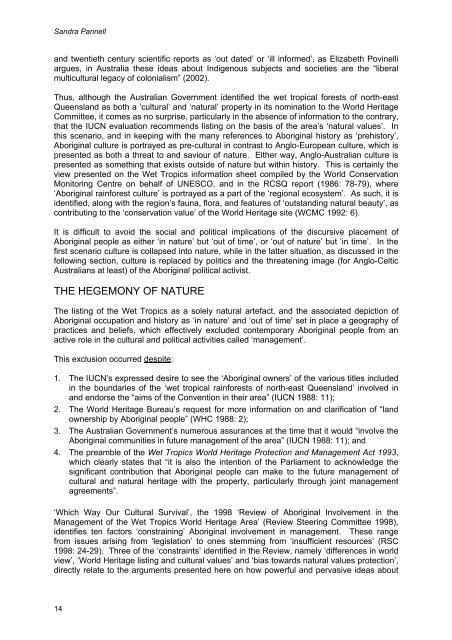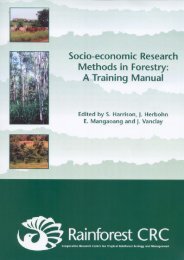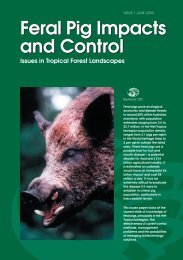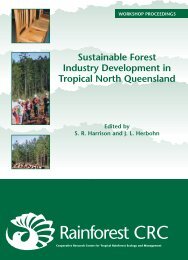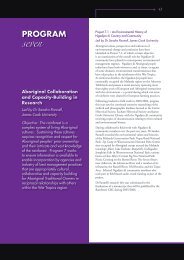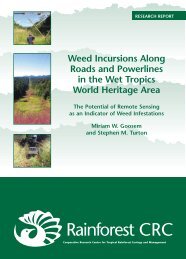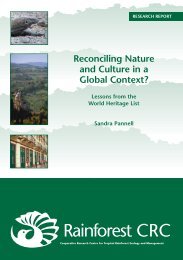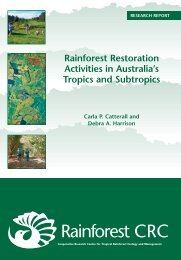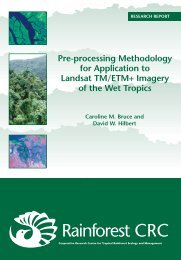S<strong>and</strong>ra Pannell<strong>and</strong> twentieth century scientific reports as ‘out dated’ or ‘ill <strong>in</strong>formed’, as Elizabeth Pov<strong>in</strong>elliargues, <strong>in</strong> Australia these ideas about Indigenous subjects <strong>and</strong> societies are the “liberalmulticultural legacy of colonialism” (2002).Thus, although the Australian Government identified the wet tropical forests of north-eastQueensl<strong>and</strong> as both a ‘cultural’ <strong>and</strong> ‘natural’ property <strong>in</strong> its nom<strong>in</strong>ation to the World HeritageCommittee, it comes as no surprise, particularly <strong>in</strong> the absence of <strong>in</strong>formation to the contrary,that the IUCN evaluation recommends list<strong>in</strong>g on the basis of the area’s ‘natural values’. Inthis scenario, <strong>and</strong> <strong>in</strong> keep<strong>in</strong>g with the many references to Aborig<strong>in</strong>al history as ‘prehistory’,Aborig<strong>in</strong>al culture is portrayed as pre-cultural <strong>in</strong> contrast to Anglo-European culture, which ispresented as both a threat to <strong>and</strong> saviour of nature. Either way, Anglo-Australian culture ispresented as someth<strong>in</strong>g that exists outside of nature but with<strong>in</strong> history. This is certa<strong>in</strong>ly theview presented on the Wet Tropics <strong>in</strong>formation sheet compiled by the World ConservationMonitor<strong>in</strong>g Centre on behalf of UNESCO, <strong>and</strong> <strong>in</strong> the RCSQ report (1986: 78-79), where‘Aborig<strong>in</strong>al ra<strong>in</strong>forest culture’ is portrayed as a part of the ‘regional ecosystem’. As such, it isidentified, along with the region’s fauna, flora, <strong>and</strong> features of ‘outst<strong>and</strong><strong>in</strong>g natural beauty’, ascontribut<strong>in</strong>g to the ‘conservation value’ of the World Heritage site (WCMC 1992: 6).It is difficult to avoid the social <strong>and</strong> political implications of the discursive placement ofAborig<strong>in</strong>al people as either ‘<strong>in</strong> nature’ but ‘out of time’, or ‘out of nature’ but ‘<strong>in</strong> time’. In thefirst scenario culture is collapsed <strong>in</strong>to nature, while <strong>in</strong> the latter situation, as discussed <strong>in</strong> thefollow<strong>in</strong>g section, culture is replaced by politics <strong>and</strong> the threaten<strong>in</strong>g image (for Anglo-CelticAustralians at least) of the Aborig<strong>in</strong>al political activist.THE HEGEMONY OF NATUREThe list<strong>in</strong>g of the Wet Tropics as a solely natural artefact, <strong>and</strong> the associated depiction ofAborig<strong>in</strong>al occupation <strong>and</strong> history as ‘<strong>in</strong> nature’ <strong>and</strong> ‘out of time’ set <strong>in</strong> place a geography ofpractices <strong>and</strong> beliefs, which effectively excluded contemporary Aborig<strong>in</strong>al people from anactive role <strong>in</strong> the cultural <strong>and</strong> political activities called ‘management’.This exclusion occurred despite:1. The IUCN’s expressed desire to see the ‘Aborig<strong>in</strong>al owners’ of the various titles <strong>in</strong>cluded<strong>in</strong> the boundaries of the ‘wet tropical ra<strong>in</strong>forests of north-east Queensl<strong>and</strong>’ <strong>in</strong>volved <strong>in</strong><strong>and</strong> endorse the “aims of the Convention <strong>in</strong> their area” (IUCN 1988: 11);2. The World Heritage Bureau’s request for more <strong>in</strong>formation on <strong>and</strong> clarification of “l<strong>and</strong>ownership by Aborig<strong>in</strong>al people” (WHC 1988: 2);3. The Australian Government’s numerous assurances at the time that it would “<strong>in</strong>volve theAborig<strong>in</strong>al communities <strong>in</strong> future management of the area” (IUCN 1988: 11); <strong>and</strong>4. The preamble of the Wet Tropics World Heritage Protection <strong>and</strong> Management Act 1993,which clearly states that “it is also the <strong>in</strong>tention of the Parliament to acknowledge thesignificant contribution that Aborig<strong>in</strong>al people can make to the future management ofcultural <strong>and</strong> natural heritage with the property, particularly through jo<strong>in</strong>t managementagreements”.‘Which Way Our Cultural Survival’, the 1998 ‘Review of Aborig<strong>in</strong>al Involvement <strong>in</strong> theManagement of the Wet Tropics World Heritage Area’ (Review Steer<strong>in</strong>g Committee 1998),identifies ten factors ‘constra<strong>in</strong><strong>in</strong>g’ Aborig<strong>in</strong>al <strong>in</strong>volvement <strong>in</strong> management. These rangefrom issues aris<strong>in</strong>g from ‘legislation’ to ones stemm<strong>in</strong>g from ‘<strong>in</strong>sufficient resources’ (RSC1998: 24-29). Three of the ‘constra<strong>in</strong>ts’ identified <strong>in</strong> the Review, namely ‘differences <strong>in</strong> worldview’, ‘World Heritage list<strong>in</strong>g <strong>and</strong> cultural values’ <strong>and</strong> ‘bias towards natural values protection’,directly relate to the arguments presented here on how powerful <strong>and</strong> pervasive ideas about14
<strong>Reconcil<strong>in</strong>g</strong> <strong>Nature</strong> <strong>and</strong> <strong>Culture</strong> <strong>in</strong> a <strong>Global</strong> <strong>Context</strong>?Lessons from the World Heritage Listculture <strong>and</strong> nature <strong>in</strong>tersect to create a discursive space, which is unable to accommodatecontemporary Indigenous constructions of identity <strong>and</strong> heritage.While the Review is correct <strong>in</strong> suggest<strong>in</strong>g that Anglo-Australian ideas about ‘wilderness’, theconcept of terra nullius <strong>and</strong> dichotomous notions of nature-culture, where culture “playssecond fiddle to […] natural values” (RSC 1998: 26), are ‘constra<strong>in</strong>ts’, the primary focus ofthe Review upon Aborig<strong>in</strong>al <strong>in</strong>volvement <strong>in</strong> regional management fails to address some ofthe more potent <strong>and</strong> pernicious effects of the list<strong>in</strong>g. These effects, I argue, relate to howhuman subjects <strong>and</strong> relations are produced through list<strong>in</strong>g-related scientific discourses aboutnature <strong>and</strong> culture.For Aborig<strong>in</strong>al people the list<strong>in</strong>g promotes, to borrow Elizabeth Pov<strong>in</strong>elli’s observation aboutthe effects of Australian multiculturalism, “a domesticated nonconflictual ‘traditional’ form ofsociality <strong>and</strong> (<strong>in</strong>ter)subjectivity” (2002: 6). Collapsed <strong>in</strong>to nature, <strong>and</strong> frozen <strong>in</strong> a supposedlypre-contact moment, Indigenous subjects are called upon “to perform an authentic difference<strong>in</strong> exchange for the good feel<strong>in</strong>gs of the nation …” (Pov<strong>in</strong>elli 2002: 6). As Pov<strong>in</strong>elli po<strong>in</strong>tsout, this scenario “<strong>in</strong>spires impossible desires” among Aborig<strong>in</strong>al people “to be thisimpossible subject” (loc. cit.). The many photogenic images of ‘Ra<strong>in</strong>forest Aborig<strong>in</strong>es’harvest<strong>in</strong>g bush tucker, erect<strong>in</strong>g traditional dwell<strong>in</strong>gs, weav<strong>in</strong>g baskets, carv<strong>in</strong>g shields <strong>and</strong>swords, identify<strong>in</strong>g stone fish traps, <strong>and</strong> pa<strong>in</strong>t<strong>in</strong>g up <strong>in</strong> ‘traditional design’, which adorn WetTropics Management Authority (WTMA) posters <strong>and</strong> fill the pages of the Authority’snewsletter, Ra<strong>in</strong>forest Aborig<strong>in</strong>al News, graphically illustrate Pov<strong>in</strong>elli’s observations.Moreover, as Bender observes, “freez<strong>in</strong>g time allows the l<strong>and</strong>scape or monuments [as wellas the people] <strong>in</strong> it to be packaged, presented <strong>and</strong> turned <strong>in</strong>to museum exhibits” (1999: 26).In keep<strong>in</strong>g with the concepts of Indigenousness <strong>and</strong> difference presented <strong>in</strong> the nom<strong>in</strong>ationdocument <strong>and</strong> <strong>in</strong> support<strong>in</strong>g reports, this imagery of ‘traditional Aborig<strong>in</strong>al culture’ contrastswith the other image of Aborig<strong>in</strong>ality presented <strong>in</strong> the WTMA newsletter, that of ‘people withpolitics’. Negotiat<strong>in</strong>g Aborig<strong>in</strong>al <strong>in</strong>volvement <strong>in</strong> the management of the Wet Tropics WorldHeritage Area <strong>and</strong> lobby<strong>in</strong>g for the renom<strong>in</strong>ation of the region for its ‘cultural’ values are theother recurrent stories, which appear <strong>in</strong> issues of the newsletter. These stories <strong>and</strong> imagesnot only reflect an <strong>in</strong>creas<strong>in</strong>g self-consciousness about what passes as ‘culture’ (as opposedto ‘politics’), but they also signal how Indigenous people <strong>in</strong> the region have oriented their“sensual, emotional <strong>and</strong> corporeal identities” (Pov<strong>in</strong>elli 2002: 8) towards the images ofAborig<strong>in</strong>al culture identified <strong>and</strong> promoted <strong>in</strong> the list<strong>in</strong>g of the Wet Tropics. In br<strong>in</strong>g<strong>in</strong>g culture<strong>in</strong>to view <strong>in</strong> this way, Aborig<strong>in</strong>al people are caught <strong>in</strong> one of the paradoxes created by Euro-Western ideas about culture. For it to be perceived as authentic <strong>and</strong> uncontrived, Aborig<strong>in</strong>alculture must rema<strong>in</strong> “concealed from the actors themselves” (We<strong>in</strong>er <strong>and</strong> Glask<strong>in</strong> 2006: 10).Aborig<strong>in</strong>al self-consciousness of culture must thus conceal the conditions of this visibility ifculture <strong>and</strong> a particular Aborig<strong>in</strong>al ‘exo-identity’ are to be seen as non-reflexive <strong>and</strong> naturallygivenaspects of Indigenous life. Given this ‘impossible st<strong>and</strong>ard of authentic traditionalculture” (Pov<strong>in</strong>elli 2002), it is perhaps not so surpris<strong>in</strong>g to hear Aborig<strong>in</strong>al people state thatthey’ve “lost their culture”. Certa<strong>in</strong>ly, it is difficult to know what has been lost or ga<strong>in</strong>ed whendeal<strong>in</strong>g with Anglo-Australian fantasies about <strong>in</strong>digeneity <strong>and</strong> difference.It is arguable whether renom<strong>in</strong>ation of the Wet Tropics for its so-called ‘cultural values’ willseriously counteract this view of ‘natural culture’, particularly given the current hegemony of‘nature’. Indeed, it appears that the wet tropical ra<strong>in</strong>forest of north-east Queensl<strong>and</strong> havealready been nom<strong>in</strong>ated <strong>and</strong> listed for its cultural values. As far as the AustralianGovernment, <strong>and</strong> many scientists, conservationists, <strong>and</strong> members of the public areconcerned, the cultural value of this area lies <strong>in</strong> its nature, <strong>and</strong> it is this specific culturalread<strong>in</strong>g <strong>and</strong> construction of the concept of nature that is given priority <strong>and</strong> is preservedthrough list<strong>in</strong>g. Contrary to what many people believe, Aborig<strong>in</strong>al people have not been leftout of this picture of pure nature. Rather, they <strong>and</strong> their ‘culture’ are collapsed <strong>in</strong>to this viewof nature <strong>and</strong> presented as part of the evolutionary record of the region. Speak<strong>in</strong>g of the15


